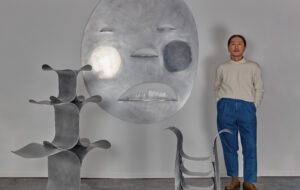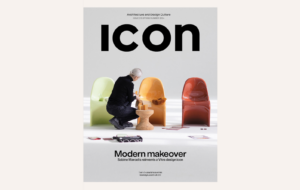


words Marcus Fairs
Dieter Rams lives in a house he designed for himself and his wife at Kronberg, near Frankfurt, not far from the giant Braun factory complex where he worked as head of industrial design. Most of the objects in the house – the furniture, the electrical goods, the shelving and even the door handles – were designed by Rams, making it a living museum of one of the most important designers of the last century.
Rams worked at Braun for 40 years and almost everything in the house predates 1997, the year he retired. “I don’t have a computer,”‘ says Rams who, at 71, looks impressively fit and is slightly intimidating. His lean face has the same lost stare of the old photos of him although his hair is now white. “I don’t like computers. I still like to do my drawings by hand.”
After the welcoming formalities, Rams takes us downstairs to his study – the modest, flat-roofed house is built into a hillside, and the front door is on the uppermost level. The tidy white room overlooks a Japanese-style garden that he tends himself and a small heated swimming pool in which he swims every day. “It’s very important for me,” Rams says. “I have some problems with my back, and I use it for my exercises.”
An entire wall of the study is covered with the modular 606 Universal Shelving System that Rams designed for furniture company Vitsoe in 1960 and which is still in production – Rams continues to modify it to this day. Dozens more of his creations occupy the room, including task lights, ashtrays, travel alarm clocks and portable radios. Mounted on the wall beside the desk is a hi-fi system with a pale aluminium finish, sharp edges and mesh-covered speakers. It looks strikingly contemporary but is more than 40 years old – only the reel-to-reel tape deck gives away its vintage. “The sound of this hi-fi is not so bad,” says Rams, in hesitant but proficient English. He gets up and switches it on: it emits a dull thud as an array of warm yellow lights flare behind the controls. As the valves warm up, the rich, warm tones of a German radio station gradually fill the room.
“At the time it was really quite new to have a hi-fi with components that you could put on the wall,” he explains. “There are a lot of things on the market now that you can mount on the wall. But this was the first one, in 1962. All the elements were designed so they could fit into the [Vitsoe] shelf system. And this was really the first turntable that was a hi-fi-quality component.”
Rams and his team at Braun did more than anyone else to popularise functional, modern mass-produced design. Most designers before him tried to make domestic appliances look like furniture or craft objects, covering up their crude circuitry with varnished woods, veneers, fabrics and decorative plastic mouldings.
Rams rejected all of this. Building on the form-follows-function methodology of the pre-war Bauhaus and the pioneering modernists, he created products that were simple to use, honest in their use of materials and stripped of all visual clutter. His products did for industrial design what the likes of Mies van der Rohe, Berthold Lubetkin and Oscar Niemeyer did for architecture. “When I started, people did loudspeakers with carpet on them, that looked like curtains,” he recalls. “It was normal at this time for electrical goods to look like furniture. I wanted more of a technical look.”
He recalls that when he proposed the mesh speaker covers for his wall-mounted system, his bosses were shocked. “The first reaction was ‘It looks like a rabbit hutch!’ But the technicians were very happy with that, because the sound came through more.”
Rams’ work also has a timeless quality that distinguishes it from the vast majority of industrial design of the mid-20th century. His products were designed to be beyond fashion and to last for a long time, in stark contrast to the throwaway styling favoured in America. Several black Braun calculators – the oldest dating back to the early Eighties and still working – are ranged on his desk. Among them is a matt-black, credit-card sized one and a couple of the larger ones with Smarties-sized buttons. “The basic design has not changed since we started in the 1980s,” says Rams.
I ask Rams how he set about designing these objects. “The first thing was that it had to be very easy for people to use; it could not be overloaded with functions that only technicians could understand. Products have to be designed in a way that they are comprehensible. We know most people don’t like to read instruction manuals. And also we had different functions in different colours; you can see that this yellow button is an important one. Having small touches of colour makes it more colourful than having the whole thing in colour. Having a cigarette lighter in colour means it can be like a flower on a table.”
Even people who have never heard of Rams will probably have owned a few of his products in their lifetimes: Braun’s distinctive alarm clocks, hairdryers, coffee makers, food processors, electric shavers, irons, slide projectors, cine cameras, flashguns, cigarette lighters and so on sold in their millions around the world and made the company a household name. While Olivetti – perhaps the only other big design-led European manufacturer in the Fifties and Sixties – is remembered for its colourful, expressive products, Braun became synonymous with functional black minimalism.
Yet Rams contends that his original product ranges were far more colourful. “At Braun also we had a lot of colours. We had the coffee makers in different colours, we had the lighters in different colours, but it was not so well known. Do you know why? Because retailers were not so willing to keep three or four colours in their storage. It didn’t come to the people.” Yet this statement sounds somewhat revisionist since in his monograph, Dieter Rams – Less But Better, he states: “It had always been my opinion not to use bright colours for Braun products… they must stay in the background, must harmonise with any environment. Strong colours could upset and confuse.”
Rams leads us into a store room filled with shelves stacked with hundreds of the smaller objects he designed. “This was really the first portable radio, the first one that had a technical look,” he says of one radio dating from the late Fifties. “At the time, all portables by the competition were done in a way that they looked like women’s handbags.” He picks up another: “This also came at the end of the Fifties, the beginning of the Sixties. It is the first radio that has all the elements on one side, so you could use it this way, use it that way, or fit it in your car. That was quite new at that time.” And another: “I like this one. It really looks like a radio! It was designed in 1961 or 62.”
On the floor is his T1000 eight-band shortwave radio, dating from 1963 and designed after a Braun director expressed a desire for something he could take on his yacht. “It looks very contemporary; of course today you can make them much smaller,” he says. With its aluminium casing, perforated skin and radiused corners, it strongly resembles the styling of the new Apple G5 computer. “Yeah, yeah, absolutely,” says Rams when I point this out. “A German magazine said, look, Rams did this years ago, but this is normal.”
Surprisingly, one of the shelves holds rows of Gillette safety razors and Oral-B toothbrushes. These familiar objects are among the least known but most ubiquitous of Rams’ designs – the razor was only recently discontinued, and the toothbrush was his best-selling product. They were both designed for Gillette shortly after the American giant acquired Braun in 1967. Rams spent much of the latter part of his career resisting what he saw as the pernicious influence of the new parent, which was ruled by accountants and driven by the marketing men. “This was the first time and the last time I designed for Gillette. Some of the chairmen of Gillette were former chairmen at Braun. They came back to me and said ‘can you design us a toothbrush?'”
Rams still sounds bitter about the way Gillette diluted Braun’s unique culture, in which designers, technicians and industrialists worked hand in hand to produce extraordinary products. Everything was done in-house: Rams oversaw graphic and packaging design, advertising and even the design of Braun’s buildings and interiors. “I didn’t design everything by myself,” he says. “I had 24 people in the design team, including model makers and the secretarial department and the graphic design department. It was never so that I gave ideas to my colleagues; we worked together. That’s how we influenced all the other departments; influenced how the engineers worked, how the sales people worked. But I was involved in everything and responsible for everything. I personally designed most of the things for the hi-fi range.”
Braun was committed to innovation and Rams and his team were encouraged to push their work to its limits. “At Braun they were always willing to take a risk – nobody could tell you if a product would become successful. We as designers cannot work in a vacuum. The entrepreneur has to want it; the people at the top of the company have to want it.” Rams is nostalgic for what he perceives to be a golden age of design: “What’s missing today is that these kind of entrepreneurs are no longer there. Today there is only Apple and to a lesser extent Sony, but not to the same degree as was the case with Olivetti and Braun, or Peter Behrens at AEG, or Herman Miller and Charles Eames, Florence Knoll with Saarinen and so on. These kinds of connections are missing today.”
Rams studied architecture and interior design at Wiesbaden, graduating in 1953 and working briefly in an architects’ office before joining Braun in 1955. The electrical goods company had been founded in 1921 by engineer Max Braun, inventor of a revolutionary electrical shaving system. On his death in 1951 his visionary sons Artur and Erwin took over the business and transformed it into a model company complete with a health service, sports facilities and health food restaurants for employees.
They also aspired to develop a much expanded range of products that, they hoped, would not just be stylish but which would be of higher intrinsic worth than anything else available. They hired leading designer Hans Gugelot – a teacher at the influential Ulm design school – to develop a radical new range of radios and phono sets, which set the tone for the functional modernism that would become the company’s hallmark and which caused a sensation when they were first exhibited in 1955.
Rams thrived in this heady, utopian work environment and very quickly produced his first masterpiece: the 1956 SK4 phonograph. Nicknamed Snow White’s Coffin, this was the forerunner of the modern hi-fi system. The metal and wood box is unadorned save for the linear speaker grilles; for the first time, all the controls were placed on top of the unit and – again for the first time – were protected by a transparent plastic lid.
The SK4 was hugely influential, and Rams went on to design the first component audio system, the first portable world-band radio and the first transistor radio that could be fitted into a car – the Braun range won every international design prize going. The designs were initially considered avant-garde and the Braun brothers encouraged Rams to design modern furniture for companies such as Vitsoe in the hope that this would help domestic taste catch up with their products. “Irwin Braun was interested in having more modern design furniture on the market, because it helped the radios and the hi-fis,” says Rams. Besides the Universal Shelving System – which line the homes and offices of architects everywhere – Rams designed a number of other products for Vitsoe including the 601 and 620 chair programmes, both of which feature in Rams’ living room.
As the fusty Fifties gave way to the more progressive Sixties, Braun’s modern aesthetic was suddenly in tune with the zeitgeist. Technology and modernity became desirable commodities and Rams’ products combined both. “At this time, jazz – especially cool jazz – was very popular in Germany, and that needed a more clear, crystalline sound,” says Rams, pointing out that his metal speaker casings produced a crisper sound than the heavy cabinetry of his rivals. To demonstrate, he leads us into the guest bedroom on the lower level of the house – a dimly lit Sixties-style shag pad with another reel-to-reel audio system. He switches on the power and engages the tape, which belts out a rich burst of Oscar Petersen.
Despite the success of Rams’ kitchen gadgets, beauty products and toothbrushes, it is clear that he is most fond of the audio equipment: the house is full of macho hardware. Back in his study, he takes out one of his prized possessions: the TP1 from 1959. It looks not unlike a very large iPod and features a portable transistor radio which locks together with a miniature turntable, creating what Rams claims to be the precursor of the portable stereo. “What I want to show you is the combination I did in 1959. This radio in combination with the record player was the first Walkman! It was made for 45s – you snap the record on like this, the stylus comes out from underneath. You could really walk with it! The loudspeaker was not so good but the earphone was not bad. Now it’s a very expensive item for collectors. The Metropolitan Museum of Art in New York approached me saying they wanted one but it was very hard for me to find one.”
Rams takes us on a quick tour of his workshop in the basement, where tools are meticulously laid out. In his monograph, he says that his interest in design stemmed from watching his grandfather lovingly craft wooden items, and this den seems to be an important refuge to Rams, who concedes he is a “night person” and no doubt spends the small hours beavering away down here. “I used the workshop at the time I was with Braun for very, very top-secret things,” he explains. “And now I use it only for making smaller models for furniture. No big things, just first studies.”
Ingeborg, Rams’ wife, calls us to lunch upstairs. As we eat, Rams opines on leading contemporary designers – a conversation triggered by the fact that the dining table features the Pepe le Moko salt cellar that Jasper Morrison designed for Alessi. It’s one of the few objects in the house not designed by Rams, who expresses his admiration for the British designer despite his dislike of Alessi’s frivolous output.
He continues: “I have nothing against star designers like Philippe Starck. He has done some great things, no doubt about it, but also a lot of things that don’t seem to have a use. As designers we have a great responsibility. I believe designers should eliminate the unnecessary. That means eliminating everything that is modish because this kind of thing is only short-lived. But a company like Braun can prove that a product that is no longer up to date can still be used. They can be very proud that nobody is throwing them away. I know a lot of people who have still got these products.”




















